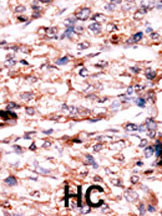PSKH1 Antibody (N-term H70)
Purified Rabbit Polyclonal Antibody (Pab)
- 产品详情
- 实验流程
- 背景知识
Application
| WB, IHC-P, E |
|---|---|
| Primary Accession | P11801 |
| Other Accession | Q0V7M1 |
| Reactivity | Human |
| Predicted | Bovine |
| Host | Rabbit |
| Clonality | Polyclonal |
| Isotype | Rabbit IgG |
| Calculated MW | 48035 Da |
| Antigen Region | 55-91 aa |
| Gene ID | 5681 |
|---|---|
| Other Names | Serine/threonine-protein kinase H1, Protein serine kinase H1, PSK-H1, PSKH1 |
| Target/Specificity | This PSKH1 antibody is generated from rabbits immunized with a KLH conjugated synthetic peptide between 55-91 amino acids from the N-terminal region of human PSKH1. |
| Dilution | WB~~1:1000 IHC-P~~1:100~500 E~~Use at an assay dependent concentration. |
| Format | Purified polyclonal antibody supplied in PBS with 0.09% (W/V) sodium azide. This antibody is prepared by Saturated Ammonium Sulfate (SAS) precipitation followed by dialysis against PBS. |
| Storage | Maintain refrigerated at 2-8°C for up to 2 weeks. For long term storage store at -20°C in small aliquots to prevent freeze-thaw cycles. |
| Precautions | PSKH1 Antibody (N-term H70) is for research use only and not for use in diagnostic or therapeutic procedures. |
| Name | PSKH1 |
|---|---|
| Function | Serine/threonine protein kinase that may be involved in the regulation of pre-mRNA processing. It may phosphorylate components of nuclear splice factor compartments (SFC), such as non-snRNP splicing factors containing a serine/arginine-rich domain (SR proteins). Reversible phosphorylation of SR proteins may cause their release into the nucleoplasm and change their local concentration, thereby influencing alternative splicing. |
| Cellular Location | Golgi apparatus. Cytoplasm, cytoskeleton, microtubule organizing center, centrosome. Nucleus speckle. Endoplasmic reticulum membrane; Lipid-anchor. Cell membrane; Lipid-anchor. Cytoplasm. Note=Localized in the brefeldin A- sensitive Golgi compartment, at centrosomes, in the nucleus with a somewhat speckle-like presence, membrane-associated to the endoplasmic reticulum (ER) and the plasma membrane (PM), and more diffusely in the cytoplasm (PubMed:11087665, PubMed:14644153). Found to concentrate in splicing factor compartments (SFCs) within the nucleus of interphase cells (PubMed:11087665). The acylation-negative form may be only cytoplasmic and nuclear. Acylation seems to allow the sequestering to the intracellular membranes. Myristoylation may mediate targeting to the intracellular non-Golgi membranes and palmitoylation may mediate the targeting to the Golgi membranes. Dual acylation is required to stabilize the interaction with Golgi membranes |
| Tissue Location | Expressed in all tissues and cell lines tested with the highest level of abundance in testis |
For Research Use Only. Not For Use In Diagnostic Procedures.
Provided below are standard protocols that you may find useful for product applications.
BACKGROUND
PSKH1 may be a SFC-associated serine kinase (splicing factor compartment-associated serine kinase) with a role in intranuclear SR protein (non-snRNP splicing factors containing a serine/arginine-rich domain) trafficking and pre-mRNA processing. PSKH1 is localized in the Brefeldin A-sensitive Golgi compartment, at centrosomes, in the nucleus with a somewhat speckle-like presence, membrane-associated to the endoplasmic reticulum (ER) and the plasma membrane (PM), and more diffusely in the cytoplasm.
REFERENCES
Brede, G., et al., Exp. Cell Res. 291(2):299-312 (2003).
Brede, G., et al., Nucleic Acids Res. 30(23):5301-5309 (2002).
Brede, G., et al., Genomics 70(1):82-92 (2000).
Amarzguioui, M., et al., Nucleic Acids Res. 28(21):4113-4124 (2000).
Larsen, F., et al., Hum. Mol. Genet. 2(10):1589-1595 (1993).
终于等到您。ABCEPTA(百远生物)抗体产品。
点击下方“我要评价 ”按钮提交您的反馈信息,您的反馈和评价是我们最宝贵的财富之一,
我们将在1-3个工作日内处理您的反馈信息。
如有疑问,联系:0512-88856768 tech-china@abcepta.com.























 癌症的基本特征包括细胞增殖、血管生成、迁移、凋亡逃避机制和细胞永生等。找到癌症发生过程中这些通路的关键标记物和对应的抗体用于检测至关重要。
癌症的基本特征包括细胞增殖、血管生成、迁移、凋亡逃避机制和细胞永生等。找到癌症发生过程中这些通路的关键标记物和对应的抗体用于检测至关重要。 为您推荐一个泛素化位点预测神器——泛素化分析工具,可以为您的蛋白的泛素化位点作出预测和评分。
为您推荐一个泛素化位点预测神器——泛素化分析工具,可以为您的蛋白的泛素化位点作出预测和评分。 细胞自噬受体图形绘图工具为你的蛋白的细胞受体结合位点作出预测和评分,识别结合到自噬通路中的蛋白是非常重要的,便于让我们理解自噬在正常生理、病理过程中的作用,如发育、细胞分化、神经退化性疾病、压力条件下、感染和癌症。
细胞自噬受体图形绘图工具为你的蛋白的细胞受体结合位点作出预测和评分,识别结合到自噬通路中的蛋白是非常重要的,便于让我们理解自噬在正常生理、病理过程中的作用,如发育、细胞分化、神经退化性疾病、压力条件下、感染和癌症。







